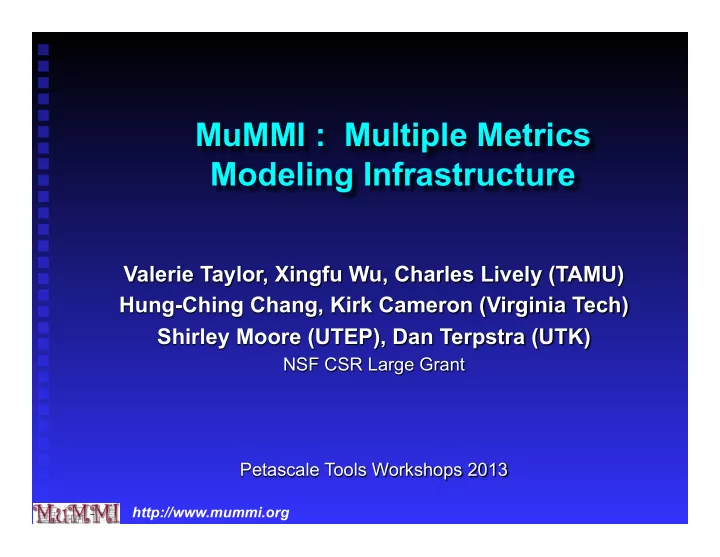

MuMMI : Multiple Metrics Modeling Infrastructure Valerie Taylor, Xingfu Wu, Charles Lively (TAMU) Hung-Ching Chang, Kirk Cameron (Virginia Tech) Shirley Moore (UTEP), Dan Terpstra (UTK) NSF CSR Large Grant Petascale Tools Workshops 2013 http://www.mummi.org
Motivation Rank Name Vendor # Cores R MAX (PFLOPS/S) Power (MW) 1 Tianhe-2 NUDT 3,120,000 33.9 17.8 2 Titan Cray 560,640 17.6 8.3 3 Sequoia IBM 1,572,864 17.2 7.9 4 K computer Fujitsu 705,024 10.5 12.7 5 Mira IBM 786,432 8.16 3.95 Source: Top500 list (June 2013) http://www.mummi.org
MuMMI (Multiple Metrics Modeling Infrastructure) Project Application E-AMOM PAPI PowerPack Database Multicore/Heterogeneous System for Execution http://www.mummi.org
E-AMOM n Start with large set of counters n Refine set to identify important counters n Regression analysis to obtain equations n Focus on: u Runtime u System power u CPU power u Memory power http://www.mummi.org
Counters PAPI_TOT_INS PAPI_L2_ICM PAPI_FP_INS PAPI_CA_SHARE PAPI_LD_INS PAPI_HW_INT PAPI_SR_INS PAPI_CA_ITV PAPI_TLB_DM PAPI_BR_INS PAPI_TLB_IM PAPI_RES_STL PAPI_VEC_INS Cache_FLD_per_instruction PAPI_L1_TCA LD_ST_stall_per_cycle bytes_out PAPI_L1_ICA bytes_in PAPI_L1_ICM IPC0 ¡ PAPI_L1_TCM IPC1 ¡ PAPI_L1_DCM IPC2 ¡ PAPI_L1_LDM IPC3 ¡ PAPI_L1_STM IPC4 ¡ PAPI_L2_LDM IPC5 ¡ PAPI_TOT_INS http://www.mummi.org
First Reduction: Spearman Correlation Example: NAS BT-MZ with Class C Hardware Counter Correlation Value Hardware Counter Correlation Value PAPI_TOT_INS 0.9187018 PAPI_L1_ICA 0.4876423 PAPI_FP_OPS 0.9105984 PAPI_L1_ICM 0.4449848 PAPI_L1_TCA 0.9017512 0.4017515 PAPI_L2_ICM PAPI_L1_DCM 0.8718455 0.3718456 PAPI_CA_SHARE PAPI_L2_TCH 0.8123510 0.3813516 PAPI_HW_INT PAPI_L2_TCA 0.8021892 0.3421896 PAPI_CA_ITV Cache_FLD 0.7511682 Cache_FLD 0.3651182 PAPI_TLB_DM 0.6218268 PAPI_TLB_DM 0.3418263 PAPI_L1_ICA 0.5487321 PAPI_L1_ICA 0.2987326 Bytes_out 0.5187535 Bytes_in 0.26187556 http://www.mummi.org
Regression Analysis Counter Regression Coefficient PAPI_TOT_INS 1.984986 PAPI_FP_OPS 1.498156 PAPI_L1_DCM 0.9017512 PAPI_L1_TCA 0.465165 PAPI_L2_TCA 0.0989485 PAPI_L2_TCH 0.0324981 Cache_FLD 0.026154 PAPI_TLB_DM 0.0000268 PAPI_L1_ICA 0.0000021 Bytes_out 0.000009 http://www.mummi.org
Training Set n 12 training set points u Intra-node: 1x1, 1x2, 1x3 at 2.8 GHz and 1x4, 1x6, 1x8 at 2.4 Ghz u Inter-node: 1x8, 3x8, 5x8 at 2.8 Ghz and 7x8, 9x8,10x8 at 2.4 Ghz n Predicted 30 points beyond of training set and validated experimentally : u 1x4, 1x6, 1x8, 2x8, 4x8, 6x8, 7x8, 8x8, 9x8, 10x8, 11x8, 12x8, 13x8, 14x8, 16x8 at 2.8Ghz u 1x1, 1x2, 1x3, 1x5, 2x8, 3x7, 4x8, 5x8, 6x8, 8x8, 11x8, 12x8, 14x8 16x8 at 2.4 Ghz http://www.mummi.org
SystemG (Virginia Tech) Configuration of SystemG Total Cores 2,592 Total Nodes 324 Cores/Socket 4 Cores/Node 8 CPU Type Intel Xeon 2.8Ghz Quad-Core Memory/Node 8GB L1 Inst/D-Cache per core 32-kB/32-kB L2 Cache/Chip 12MB Interconnect QDR Infiniband 40Gb/s http://www.mummi.org
Modeling Results: Hybrid Applications http://www.mummi.org
Modeling Results: MPI Applications http://www.mummi.org
Performance-Power Optimization Techniques n Reducing power consumption u Dynamic Voltage and Frequency Scaling (DVFS) u Dynamic Concurrency Throttling (DCT) n Shortening application execution time u loop optimization: blocking and unrolling http://www.mummi.org
Optimization Strategy 1. Input: given HPC application 2. Determine performance of each application kernel 3. Determine configuration settings – setting for DVFS, DCT, or DVFS +DCT 4. Estimate performance 5. Apply loop optimizations 6. Use new configuration settings http://www.mummi.org
Optimization Strategy: Parallel EQdyna n Apply DVFS u initialization u hourglass kernel u final kernels n Apply DCT u improved configuration using 2 threads for hourglass and qdct3 kernels n Additional loop optimizations u block size = 8x8 u loop unrolling to respective kernels http://www.mummi.org
Optimization Results: EQDyna Total Energy Total Power #Cores EqDyna Type Runtime(s) (KJ) (W) Hybrid 458 132.36 289.03 16x8 422 111.83 265 Optimized-Hybrid (-8.5%) (-18.35%) (-9.1%) Hybrid 261 75.37 288.79 32x8 246 64.23 261.11 Optimized-Hybrid (-6.1%) (-17.34%) (-10.6%) Hybrid 151 42.08 278.67 64x8 145 36.23 249.89 Optimized-Hybrid (-4.14%) (-16.15%) (-11.52%) http://www.mummi.org
Optimization Strategy: GTC n Apply DVFS u initialization, u first 25 time steps of application u final kernels n Apply DCT u optimal configuration using 6 threads for pusher kernels after 30 time steps n Additional loop optimizations u block size = 4x4 (100ppc) http://www.mummi.org
Optimization Results: Hybrid GTC Total Energy #Cores GTC Type Runtime(s) Total Power (W) (KJ) Hybrid 453 132.82 293.19 16x8 421 116.34 276.35 Optimized-Hybrid (-7.6%) (-14.16%) (-6.1%) Hybrid 455 134.03 294.58 32x8 424 118.44 279.35 Optimized-Hybrid (-7.31%) (-13.16%) (-5.45%) Hybrid 436 128.53 294.79 64x8 423 114.72 271.12 Optimized-Hybrid (-3.1%) (-12.03%) (-8.73%) http://www.mummi.org
Future Work n Energy-Aware Modeling u Performance models of CPU+GPGPU systems u Support additional power measures: IBM EMON API for BG/Q, Intel RAPL, NVIDIA Power Management u Collaborations with Score-P n Additional Energy-Aware Optimizations u Exploration the use of correlations among counters to provide optimization insights u Exploring different classes of applications http://www.mummi.org
Recommend
More recommend